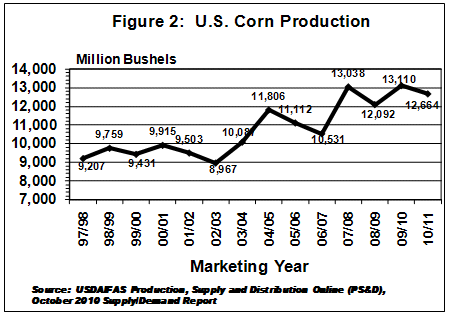Vol. 26, Issue 30, October 27, 2010 – PDF version
Jose G. Peña, Texas AgriLife Extension Economist-Management
Prices for grain and cotton continue to show significant strength. While it may be difficult for farmers to take advantage of this season’s market surge, the market is providing excellent pricing opportunities for 2011 crops. (See Figure 1).
Near-by futures prices for corn and cotton jumped to record highs this past week. The surge in corn began as USDA’s October 8, 2010 supply/demand report lowered the U.S. corn production estimate by almost one-half billion bushels after forecasting a record corn crop since May 2010. Near-by cotton futures prices jumped almost 20 cents this past week to record high futures prices, heavily influenced by concern that global demand, especially from China, may exceed supplies and adverse weather, including reports of heavy hail storms in the panhandle of Texas.
Corn and cotton futures weakened on Wednesday (10/27/10), when this report was prepared, but markets remained relatively strong.
Earlier, it appeared that the market improvement was related to market spill-over from the surge in wheat prices as a severe drought, record high temperatures and extended wildfires in Russia caused a shortage of wheat. Now, it appears that a much lower corn production estimate as a result of adverse weather conditions, a weaker U.S. dollar, news that China will be buying more U.S. corn, higher crude oil prices, and heavy commodity contract buying by hedge funds have all contributed to the market improvement. A weaker U.S. dollar encourages exports and higher crude oil prices affects corn prices because of the high demand for corn for ethanol production. The estimate of corn use for ethanol production will account for about 37.1 percent of USDA’s October 2010 corn production estimate of 12.664 billion bushels. Hedge funds are buying near-by commodity futures contracts as a safer investment to hedge against potential inflation.
Feeder and live cattle futures prices have been showing some recovery after recent weakness, but the livestock industry, especially pork and poultry producers, continues to express serious concerns from signals of higher feed costs.
Corn
While the U.S. corn harvest is about 43 percent ahead of the five year average for this time of the year, USDA’s October 8, 2010 supply/demand report decreased the corn production estimate by 496 million bushels from last month’s estimate. (See Figure 2). The estimate of acres for harvest was increased by 258,000 acres, but the U.S. average yield was lowered by 6.7 bu./ac. to 155.8 bu./ac. Beginning stocks were increased by 392 million bushels based on the September 2010 stock estimate. But, despite the increase in beginning stocks, the almost one-half billion drop in the forecast production and higher projected domestic disappearance, the estimate of ending stocks was reduced sharply from last month’s estimate. Feed and residual use was increased by 150 million bushels but the estimate of exports was lowered 100 million bushels as a result of tighter available supplies, reduced demand from higher prices, and increased competition from Argentina. U.S. ending stocks are now projected lower at 902 million bushels, down 214 million bushels from last month’s estimate.
The season-average farm price was projected at $4.60 to $5.40/bu., up 60 cents on both ends of the range.
Cotton
USDA’s October 8, 2010 supply/demand report remained virtually unchanged from last month. Production was raised marginally, as increases for the Delta and the Southwest region were nearly offset by reductions from the Southeast region. Domestic mill use and exports remained unchanged.
The estimate of U.S. ending stocks at 2.7 million bales also remained unchanged from last month’s estimate, but down 25 million bales from last year. The average price received by producers was forecast at 67-79 cents per pound, about four cents above last month. The midpoint of the range, is 10 cents above the final 2009/10 marketing-year average price of 62.9 cents per pound.
While the value of the U.S. dollar has been showing significant weakness since mid-June’s highs, the index showed a slight up-turn this past week and may have influenced the market weakness on Wednesday (10/27/10), but it seems likely that markets will remain relatively strong.
Appreciation is expressed to Dr. Jackie Smith, Extension Economist for his contribution to and review of this article.


